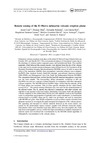Please use this identifier to cite or link to this item:
https://accedacris.ulpgc.es/jspui/handle/10553/11832
| Title: | Remote sensing of the El Hierro submarine volcanic eruption plume | Authors: | Coca, Josep Ohde, Thomas Redondo, Alexandre García Weil, Luis Ramos, Antonio G. Santana-Casiano, Magdalena González-Dávila, Melchor Arístegui, Javier Fraile Nuez,Eugenio |
UNESCO Clasification: | 250108 Óptica atmosférica 2510 Oceanografía 250616 Teledetección (Geología) |
Keywords: | El Hierro Volcanic eruption MODIS Remote sensing Sulphide, et al |
Issue Date: | 2014 | Journal: | International Journal of Remote Sensing | Abstract: | Submarine volcanic eruptions took place at the island El Hierro (Canary Islands) between October 2011 and March 2012. The event produced plumes of discoloured waters due to the discharge of volcanic matter, magmatic gases, and hydrothermal fluids. The expelled materials, which behaved like oceanic tracers, were detected from the site of the volcano to the open sea by remote-sensing techniques using different level-2 (L2) products of the Moderate Resolution Imaging Spectroradiometer (MODIS) sensor. In order to assess the effect of the anomalous turbidity, three atmospheric correction schemes were evaluated: SeaWiFS Data Analysis System (SeaDAS) standard, near-infrared–shortwave-infrared (NIR-SWIR), and Management Unit of the North Sea Mathematical Models (MUMM). The comparison between them verified that the SeaDAS standard atmospheric correction was the most suitable. The downwelling diffuse attenuation coefficient at 490 nm (Kd(490)) was used as a measure of plume intensity in comparison with other submarine volcanic eruptions. The MODIS-derived Kd(490) values verified that the intensity of the El Hierro plume was moderate. Only in some specific situations did the values barely exceed 0.4 m–1. The remote-sensing reflectance (Rrs) was used for the characterization of the affected waters. The Rrs spectra also allowed a comparison with other volcanic and sulphide events reported in previous studies. Similarities were found, both with submarine volcanic eruptions in the southwestern Pacific and with sulphide events at the Namibian coast, in composition and properties of optically active water constituents. A classification schema based on Kd(490) values and Rrs ratios was developed and used in connection with MODIS red–green–blue (RGB) composites as well as surface current velocities from altimeter missions to investigate the spatio-temporal development of the volcanic plume. The spreading and transport of volcanic material observed at the ocean surface was caused by the predominant surface currents coupled with different mesoscale eddies. Discoloured waters were identified more than 200 km away from the eruption site. Field data from oceanographic surveys verified the high concentration of sulphur compounds in affected waters and confirmed the overestimation by the MODIS default algorithm of chlorophyll-a concentrations in the volcanic plume. | URI: | https://accedacris.ulpgc.es/handle/10553/11832 | ISSN: | 0143-1161 | DOI: | 10.1080/01431161.2014.960613 | Source: | International Journal of Remote Sensing [ISSN 0143-1161], v. 35 (17), p. 6573-6598 |
| Appears in Collections: | Artículos |
WEB OF SCIENCETM
Citations
15
checked on Jun 8, 2025
Page view(s) 5
248
checked on Apr 20, 2024
Download(s)
225
checked on Apr 20, 2024
Google ScholarTM
Check
Altmetric
Share
Export metadata
This item is licensed under a Creative Commons License

